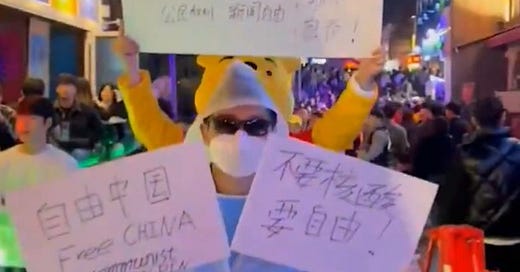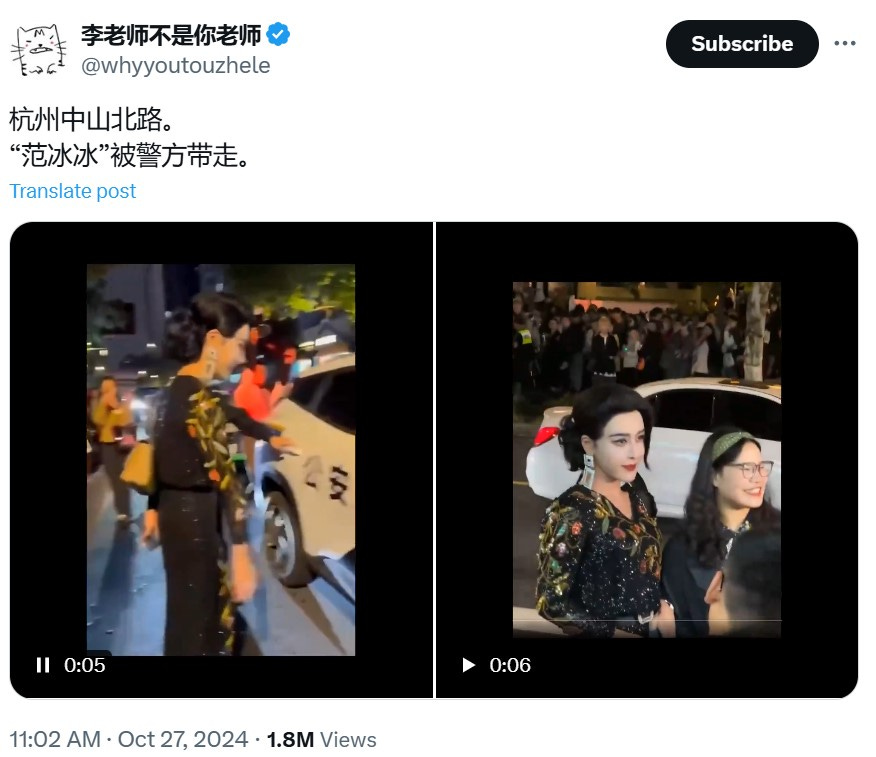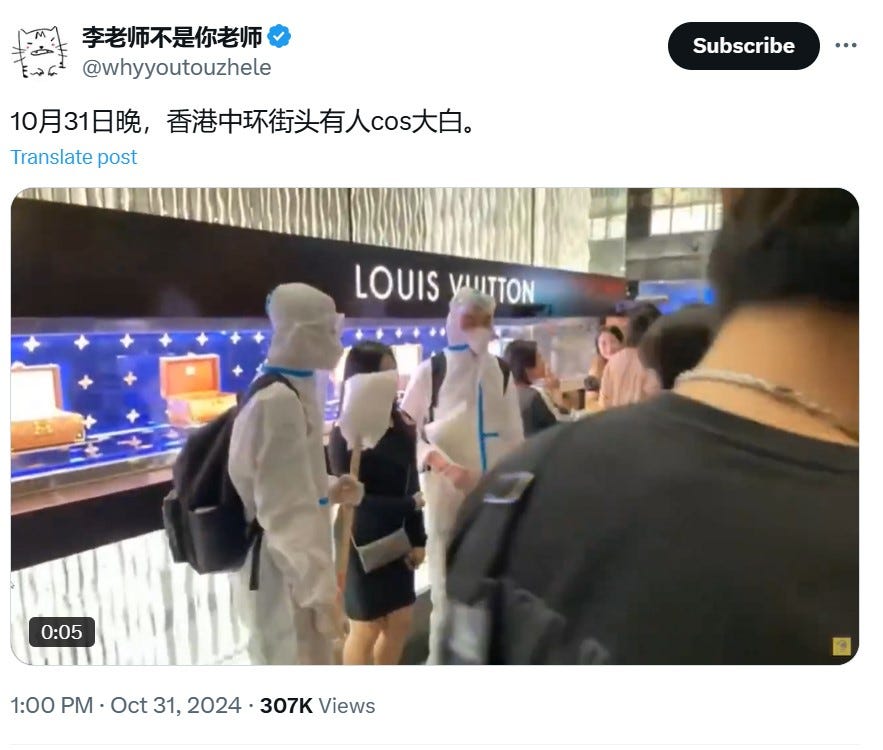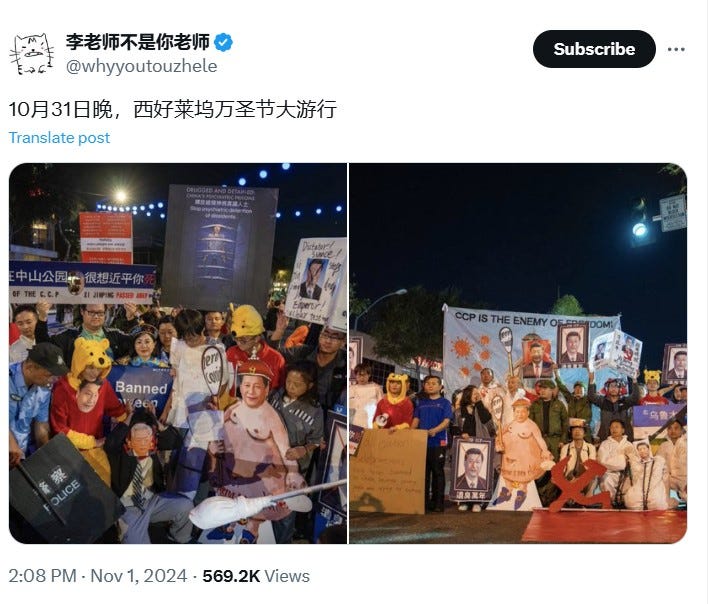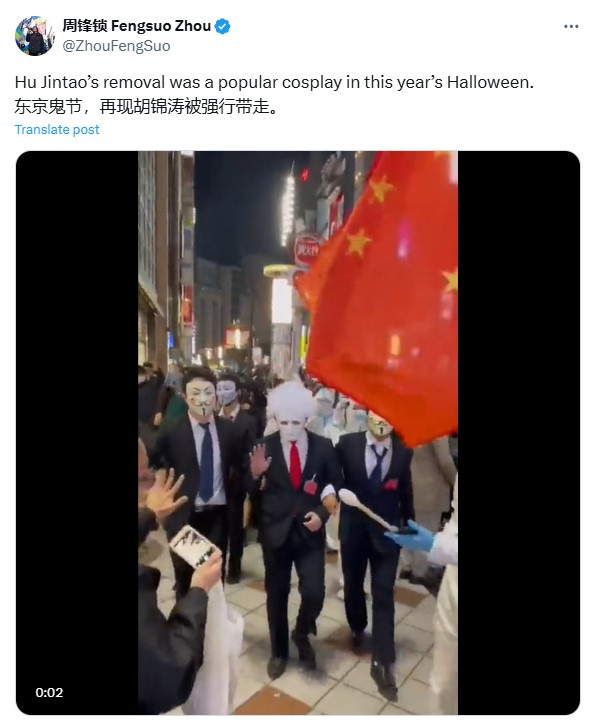Reconstructing Political Spaces: The Transformation and Resistance of Halloween Celebrations
政治空间重构: 节日的异化与反抗
后附中文版
Halloween, traditionally a ‘Western’ celebration, has undergone a profound shift in the Chinese context, evolving from a light-hearted celebration to a platform for civil expression. In 2024, Chinese authorities imposed unprecedented systematic controls to suppress this cultural expression: commercial spaces were purged, public areas placed under armed surveillance, and costumed individuals were forcibly removed from the streets. Together, such reactions reveal the Chinese regime’s deep-seated anxiety over any social activities which could foster social action. This extreme level of control under the CCP both exposed the regime’s wariness of the younger generations’ cultural expression, and also ignited a civil rights movement which spans across multiple continents.
Whole-scale Lockdowns; Intense Crackdowns
On October 24, the Taiwanese owner of a bar in Shanghai, ‘MyDog’ shared a video stating that his bar had been strictly ordered to avoid any Halloween events. Any costumes would potentially lead to an enforced shutdown. This directive encapsulates the authorities’ use of high pressure measures to prevent any costumed activities.
https://x.com/whyyoutouzhele/status/1849774606477033597
From October 25, Shanghai police erected one-meter-high iron barriers along crowded central areas, including Julu road, Huaihai road and Fuxing Park. A significant police presence was deployed to patrol these locations, where officers prevented citizens from entering public spaces if they were in costume. Anyone in costume seen exiting subway stations was immediately turned back. Many people in these areas were stopped, searched and interrogated, with some videos circulating online showing people in imperial Qing Dynasty attire being escorted away by police.
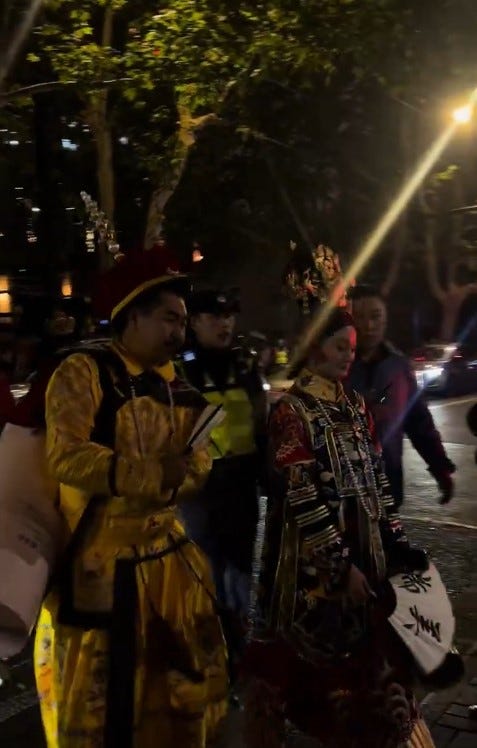
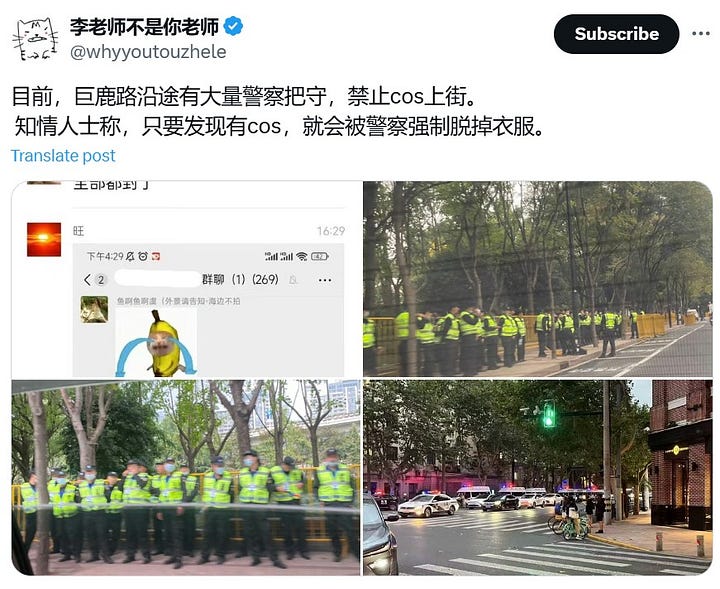
https://x.com/whyyoutouzhele/status/1849780009323593805 https://x.com/whyyoutouzhele/status/1849826329463750792
https://x.com/whyyoutouzhele/status/1850170216350884262 https://x.com/whyyoutouzhele/status/1850165840181604392 https://x.com/whyyoutouzhele/status/1850214636827926696
The following day, police intensified their measures. Zhongshan Park was cordoned off by large numbers of officers, who cleared the area under the pretext of temporarily closing the park. Numerous people in costumes were detained; forced to remove their costumes, provide personal information, and submit to questioning. Detainees were required to provide personal information, including their names, phone numbers, ID numbers and addresses. Simultaneously, hashtags and discussions related to “Shanghai Halloween” were banned across major social media platforms.
On October 27th, the government's crackdown on civil rights spread to other cities. Halloween activities were targeted in Guangzhou, Hangzhou, Nanjing, and elsewhere in China. In Hangzhou, police were sent out in large numbers to disperse and arrest people in costumes, claiming to "ban terrifying or exaggerated outfits." However, even people dressed as Fan Bingbing, Deadpool, Batman, and Jesus were taken away by the police. In Guangzhou, costumed individuals had their props confiscated and were made to remove their costumes. In Nanjing, the government ordered the shutdown of a planned Halloween-themed event called “Flowing Light Dance.”
https://x.com/whyyoutouzhele/status/1850553730372124917 https://x.com/whyyoutouzhele/status/1850541397054730486 https://x.com/whyyoutouzhele/status/1850555877344026867
https://x.com/whyyoutouzhele/status/1851236978945032382 https://x.com/whyyoutouzhele/status/1851981303874232760
By 31 October, authorities escalated restrictions to an unprecedented level. Universities issued strict orders banning students from participating in any form of Halloween activities. Major urban areas and transport hubs saw a heavy police presence, aimed at preventing any possible gatherings. In Zhuhai, ongoing Halloween celebrations in public spaces were forcibly stopped by officials.
Diverse forms of Localized Resistance
Despite the strict repression, the young generations’ desire for self expression only grew, inspiring creative forms of resistance which gave the Halloween celebrations a deeper political significance. In Shanghai, after police enforced tight control in popular areas like Julu Road and Huaihai Road, young people tactically shifted their celebrations to other locations, such as Zhongshan Park and Joy City, encouraging others to join them. Some dressed as police officers; there were also beggars, the Buddha, the Statue of Liberty, Empress Dowager Cixi, and even Chen Duxiu holding a copy of New Youth. Crowds gathered around these costumed individuals, with some shouting slogans like “freedom,” powerfully voicing their demands for self-expression.
https://x.com/whyyoutouzhele/status/1850177241705222294 https://x.com/whyyoutouzhele/status/1850193947538419976
A growing number of young people turned to social media to vent their dissatisfaction with the strict Halloween restrictions, viewing them as an overreach of authority over a spontaneous cultural event. Social platforms were filled with satire and criticism of what they believed was governmental abuse of power.
In Wuhan, residents organized a Halloween celebration where masked musicians played music and citizens joined hands and danced, subtly asserting their collective longing for freedom. Despite efforts to shut down the event, those attending continued to assert their rights to public space and lifestyle choices through music and dance.
https://x.com/whyyoutouzhele/status/1852022381516120483
https://x.com/whyyoutouzhele/status/1852041107674402935
On Lihuangpi Road in Wuhan, young people used carefully crafted costumes to deliver pointed critiques of contemporary society. One participant dressed as a corrupt official Gao Yuliang from a popular TV drama, parodying the collusion of power and systemic corruption by declaring, “Send the village dogs to serve as police and eat from the emperor’s granary.” Other participants, dressed as haggard “laborers,” highlighted the spiritual burnout experienced by young generations living under the “996” work culture.
A ‘Batman’ driving a modified Batmobile made a brief appearance on the streets before police intervened and confiscated his props. This piece of performance art echoed last year’s iconic scene of a “Batman” figure standing off against police, intertwining the fictional world’s spirit of resistance with real-life struggles. At the same time, someone dressed as the “Joker” appeared, recreating iconic scenes from the movie. This set up a critical dialogue between fiction and reality, hinting at the widespread social disorder and systemic oppression in society.
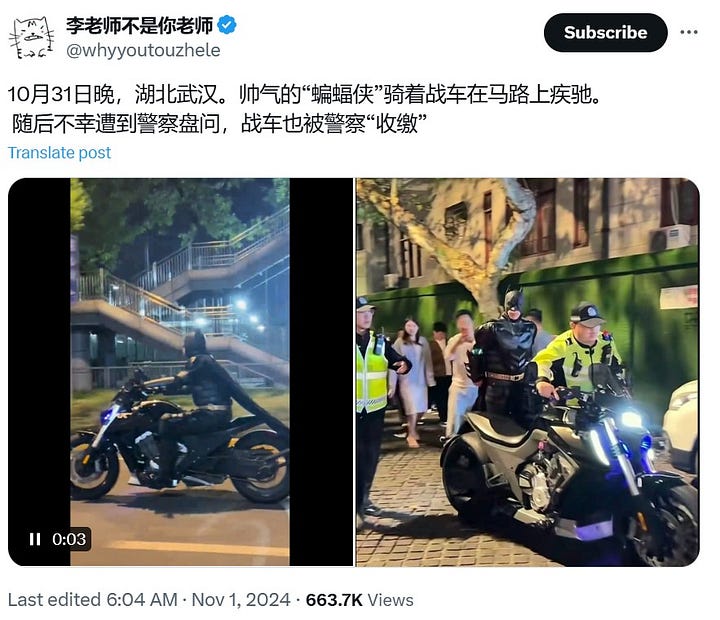
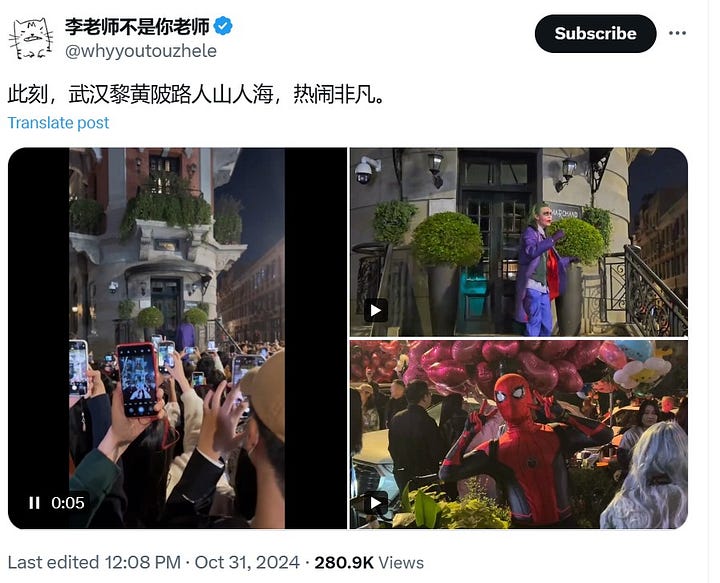
https://x.com/whyyoutouzhele/status/1852019928137904253 https://x.com/whyyoutouzhele/status/1852290594405830787
On the streets of Xi'an, people recreated a COVID-19 testing scene, with some dressed as “Dabai” (literally “Big Whites”)—the nickname for pandemic workers in white hazmat suits—performing mock tests on others. This satirical reenactment invoked and offered and provided a means of processing traumatic memories of China’s extreme COVID policies. A similar scene played out in Hong Kong's Central district, highlighting how both regions shared criticism of excessive pandemic control measures. These reenactments weren't just satirical looks at the past; they were collective protests against the violation of civil rights during the pandemic.
https://x.com/whyyoutouzhele/status/1852032942740021759
As Chinese authorities cracked down on Halloween activities, Chinese people worldwide responded with creative protests. From Seoul's Itaewon to the Chinese Embassy in London, from the consulate in Sydney to West Hollywood in Los Angeles, overseas Chinese groups showed support for young people in China facing the CCP’s suppression.
In Seoul's Itaewon, protesters cleverly adopted politically charged symbols. They linked "Winnie the Pooh" imagery to Xi Jinping, alongside slogans including "We want freedom, not COVID tests." This created a multi-layered critique of authoritarian rule. These expressions not only recalled the deep social trauma from China's pandemic period but also exposed the political control embedded in the 0-COVID policies.
https://x.com/whyyoutouzhele/status/1852013370293260304
In Tokyo's Shibuya, protesters linked struggles of the past with those in the present. They displayed signs reading "Urumqi Road" and "Sitong Bridge," tying their current protests back to the 2022 ‘White Paper Movement’. One person dressed in an emperor’s robes and a Xi Jinping mask delivered a sharp critique of China's authoritarianism and Xi’s cult of personality.
Outside the Chinese consulate in Sydney, the protest took a more direct approach. Protesters questioned why authorities feared Halloween, challenging not just the control over the holiday but also the regime's excessive interference in peoples’ daily lives.
https://x.com/whyyoutouzhele/status/1852153901337972926
https://x.com/China_Deviants/status/1852085159916384614
In front of the Chinese Embassy in London, protesters used highly symbolic costumes like the "chained woman," candles, and blank sheets of paper to compose a powerful visual narrative of oppression and resistance. This expressed these activists’ dissatisfaction with the suppression of free speech in China.
https://x.com/whyyoutouzhele/status/1852412391465857398
The protest in Los Angeles took expression to a new level of dramatism. Participants played roles like "Hu Jintao," "Xi Jinping," and "police officers," to recreate scenes from the 20th Communist Party Congress. By recreating iconic incidents such as "Hu Jintao’s removal from the Congress," they dramatically portrayed the absurdity of power transitions in China and the underlying violence in these power shifts.
The Evolution of Protest Tactics
The politicization of Halloween began with Hong Kong's 2019 anti-extradition movement, where locals first adapted this Western holiday into a vehicle for political expression. They freed it from traditional ‘spooky’ elements, and instead turned it into a space for civic defiance. This celebration allowed the younger generation the opportunity to release their pent-up social critique, and challenge official narratives through symbolic expression.
In late October 2022, Halloween parades in New York, Tokyo, and other cities demonstrated support for the "Sitong Bridge protester" (Peng Lifa; otherwise known as ‘Bridge Man’) and condemned Xi Jinping's autocratic rule. As Halloween 2023 coincided with the first anniversary of the ‘White Paper Movement’, young people found a fresh outlet for their frustration, using costumes with direct or subtle references to political and social issues.
https://x.com/ZhouFengSuo/status/1587165893083144192 https://x.com/RFA_Chinese/status/1587609529725992962
https://x.com/whyyoutouzhele/status/1719431231585034620 https://x.com/whyyoutouzhele/status/1586386014620291073 https://x.com/whyyoutouzhele/status/1719378436777554302 https://x.com/whyyoutouzhele/status/1718280882815902069 https://x.com/whyyoutouzhele/status/1719359752918949917 https://x.com/whyyoutouzhele/status/1719381549924172084 https://x.com/whyyoutouzhele/status/1719391373948846309
Some people dressed up as road signs saying "I'm in Shanghai and I really want you to die," which many interpreted as a veiled curse against Xi Jinping. Others wore the iconic hazmat suits of the ‘Big Whites’ and carried oversized cotton swabs, satirizing the extreme zero-COVID policies which swept the nation during the years prior.
Someone dressed as Lu Xun held a sign saying "Studying medicine can't save China" and read Lu Xun's works to the crowd, encouraging young people to speak up and use their voices. Another person dressed as a giant camera and stood next to police officers to mock China’s omnipresent surveillance.
One particularly clever costume referenced the film "Farewell My Concubine." The wearer dressed as the tragic character Cheng Dieyi, wearing a sign that read "Down with Cheng Dieyi." This subtly compared the character's persecution during the Cultural Revolution to China's current political regression, suggesting a new form of Cultural Revolution under Xi's rule.
Some took a more direct approach, dressing as Winnie the Pooh to openly mock China's top leader. Activist Xia Chaochuan chose a highly symbolic costume, covering himself in A4 white paper to commemorate the White Paper Revolution from a year ago.
These costumes and performances blended humor and creativity with pointed political commentary, allowing participants to express their criticisms of the current regime in a festive yet meaningful way.
A Transnational Digital Civil Society
In the ongoing tug-of-war between civil rights and authoritarian control, social media has become a bridge across geographical and political divides. Through technological means like VPNs to bypass internet censorship, millions of Chinese netizens and overseas Chinese communities have established a decentralized civil society on platforms such as Twitter, Instagram, Telegram, and Reddit. This online solidarity has fostered new models of cross-border political mobilization.
The 2024 Shanghai Halloween incident serves as a prime example. Social media accounts like "Teacher Li Is Not Your Teacher" (@whyyoutouzhele) not only recorded the protests in real-time but also inspired others to join street actions. Similarly, political demands from the 2022 New York Halloween parade echoed through these social platforms. The widespread propagation of slogans like "Down with the Communist Party" during the ‘White Paper Movement’ typifies this kind of cross-border digital interaction.
Social media has provided this transnational civic network with a tool for intellectual enlightenment and social mobilization, against the backdrop of increasingly stringent control of information under authoritarian regimes. This online civic network serves both as a means to resist information blockades, and as a social practice in constructing alternative public spheres. It offers a glimpse into new possibilities for the growth of civil society in China.
From Hong Kong to New York and the 2024 nationwide Halloween clampdown, digital and street protests have formed a mutually reinforcing relationship, highlighting the multifaceted potential for civil expression under authoritarian rule. The struggles around this holiday have linked political expression in virtual spaces and the real world, demonstrating a new future for civil society’s resistance against authoritarianism. Through the reworking of cultural symbols and use of social media, the young generation has created a new, dynamic political space. In doing so, they challenge the government’s control over discourse, and satisfy the need for grassroots expression.
This merging of real and virtual, transcending geographic boundaries, undermines the state’s monopoly on narrative and hints at the self-organizing potential of civil society in a post-authoritarian era. The politicization of Halloween and its associated protests essentially represent an attempt to break through the dilemmas of modernity. This evolving cultural resistance is becoming an indispensable driving force in China's democratization process. Halloween activities, therefore, have become a crucial symbol of civic awakening in the new era.
政治空间重构:节日的异化与反抗
万圣节作为⻄方的狂欢文化,在中国语境下已发生显著转向:从单纯的娱乐活动演变为公⺠社会 的表达阵地。2024年,中国当局以前所未有的系统性管控手段钳制这一文化表达:商业空间遭遇 全面清理,公共场域被武力管控,街头装扮者被强制带离,揭示了极权体制对任何具有集结潜力 的社会活动的深度忧虑。这种极端管制不仅暴露了政权对⻘年群体自发性文化行为的戒备,更激 发了一场跨越地域的公⺠权利抗争运动。
全面封锁与高压戒严
10月24日,上海的台湾经营者“⻨狗”在视频中透露,他经营的酒吧接到通知,要求严禁店内举行万圣节 相关活动,任何奇装异服都可能导致整顿关停。这一禁令表明,当局试图以高压手段阻止今年一 切涉及变装的行为。
https://x.com/whyyoutouzhele/status/1849774606477033597
10月25日起,上海警方在市中心的巨鹿路、淮海路、复兴公园等人流密集的地方设置一米高的铁 栅栏警戒,出动大警力巡逻戒严,禁止市⺠以cosplay形象进入公共场所,发现有装扮者走出 地 铁站,一律劝返。许多⺠众在这些地带遭到搜查盘问,检视随身物品,装扮者被要求当场卸除装 扮,网络流传影片显示,身着清朝帝后服饰的⺠众被警察带离。
https://x.com/whyyoutouzhele/status/1849780009323593805 https://x.com/whyyoutouzhele/status/1849826329463750792
10月26日,警方对采取更为严厉的应对措施。中山公园被大批警力封锁,以闭园为由清场,并大 规模拘捕装扮者,被捕⺠众不仅被强制卸妆,还需接受审讯,被要求提供姓名、电话、身份证号码 以及居住地址等。同时,”上海万圣节”等相关话题在各大社交平台遭到封禁。
https://x.com/whyyoutouzhele/status/1850170216350884262 https://x.com/whyyoutouzhele/status/1850165840181604392 https://x.com/whyyoutouzhele/status/1850214636827926696
10月27日,政府对公⺠权利侵犯的行为蔓延至其它城市,广州、杭州、南京等地万圣节活动,杭 州政府以“禁止恐怖、夸张造型”之名出动大批警察驱逐拘捕装扮者,然而范冰冰、死侍、蝙蝠 侠、 耶稣等⻆色也被警方带走,广州的装扮者被收缴道具,卸除装扮。南京举办的“流光漫舞”万圣节 主题活动也被政府勒令停办。
https://x.com/whyyoutouzhele/status/1850553730372124917 https://x.com/whyyoutouzhele/status/1850541397054730486 https://x.com/whyyoutouzhele/status/1850555877344026867
10月31日,管控升级到前所未有的程度:各大高校下发禁止令,严控学生参与任何形式的万圣节
活动;城市主要街区和交通枢纽部署大警力,试图阻断任何可能的集会。在珠海,正在进行的
万圣节⺠间庆祝活动也遭遇当局的强制停止。
https://x.com/whyyoutouzhele/status/1851236978945032382 https://x.com/whyyoutouzhele/status/1851981303874232760
本土反抗的多元实践
尽管面对极权体制的压制,不仅未能遏制年轻人的表达欲望,反而激发了更多富有创意的反抗形式,使得这场文化狂欢在压制中获得了更深层的政治意涵。
在上海巨鹿路、淮海路等地被严管后,年轻人为了维护自己的表达自由,通过战术性将活动地点 转移至中山公园和大悦城等其他区 域继续进行,并相互告知,号召前往,有人装扮成警察、乞丐、如来佛祖、自由女神、慈禧太 后、手持《新⻘年》的陈独秀...装扮者和大围观市⺠聚集合唱。在中山公园聚集的人群里,有 人高声呐喊“自由”,展现出强烈的表达诉求。
https://x.com/whyyoutouzhele/status/1850177241705222294 https://x.com/whyyoutouzhele/status/1850193947538419976
越来越多的年轻人通过网络表达了对严管的不满,认为这是自发的文化活动,对万圣节变装的限 制是公权力的滥用,社交媒体上充满了对官方滥 用权力的讽刺和质疑。
在武汉,年轻人组织了万圣节的狂欢活动,伴随着蒙面乐手的演奏,市⺠们手拉手跳舞,以一种隐晦的方式表达集体的自由意愿。尽管官方试图对活动进行封锁,年轻人仍通过舞蹈和音乐表达着对公共空间和生活方式的自由诉求。
https://x.com/whyyoutouzhele/status/1852022381516120483
在武汉黎⻩陂路,年轻人通过精心设计的⻆色扮演,展现了对现实社会的深刻批判。一位扮演电 视剧贪官”高育良”的装扮者,以”把村里的狗送去当警犬吃皇粮"的讽刺性台词,巧妙揭示权力 腐败与体制共谋;几名画着憔悴妆容的"打工人"装扮,则直指当代⻘年在内卷化社会中的生存困境,反映出"996"文化下一代人的精神枯竭。 https://x.com/whyyoutouzhele/status/1852041107674402935
一位驾驶改装战⻋的”蝙蝠侠”在街头的短暂巡游,虽最终被警方制止并没收道具,但这一行为艺 术恰与去年"蝙蝠侠"背对警力站立的经典画面形成互文,将虚构世界的反抗精神与现实处境巧妙 连结。同时段出现的"小丑"⻆色,通过还原电影《小丑》中的标志性场景,架构起虚构与现实之间的批判性对话,暗示着社会失序与制度性压迫的普遍存在。
https://x.com/whyyoutouzhele/status/1852019928137904253 https://x.com/whyyoutouzhele/status/1852290594405830787
在⻄安街头,⺠众现疫情时期的核酸检测场景,扮演”大白”为其他装扮者做核酸检测,以戏谑 方式回应极端防疫政策的创伤记忆。这一场景在香港中环街头得到呼应,是两地⺠众对疫情期间 过度管控的共同批判。这种创伤性的画面现,不仅是对历史的讽刺性回顾,更是对公⺠权利被 侵犯的集体控诉。
https://x.com/whyyoutouzhele/status/1852032942740021759
离散抗争的全球化动员中国当局严控万圣节活动引发全球华人以创意方式接力抗议。从首尔梨泰院到伦敦使馆,从悉尼领事馆到洛杉矶⻄好莱坞,海外华人群体以更直接的方式,声援遭受打压的中国年轻人。
在首尔梨泰院,抗议者巧妙运用政治符号,通过”维尼”与习近平的形象关联,配合”不要核酸要自 由"的诉求标语,构建了对极权统治的多层次批判。这种表达不仅呼应了中国疫情期间的社会创 伤,更揭示了防疫政策背后的政治控制本质。
东京涩谷的抗议活动则建立起历史的连续性。示威者通过展示”乌鲁木⻬路”和”四通桥”路牌,将 当下抗争与2022年白纸革命的公⺠抗议相连接。一位身着皇袍、戴习近平面具的装扮者,其表演艺术化地呈现了对中国极权主义和个人崇拜的尖锐批评。
https://x.com/whyyoutouzhele/status/1852013370293260304
悉尼领事馆前的抗议采取了更为直接的质询方式。直指当局对万圣节的恐惧,不仅质疑当局对万圣节的管控,更深层地挑战了政权对公⺠生活空间的过度干预。
https://x.com/whyyoutouzhele/status/1852153901337972926
在伦敦使馆前,抗议者通过”铁链女”、蜡烛、白纸等极具象征性的装扮,构建出压迫与反抗的视 觉叙事,表达对压制言论自由的不满。
https://x.com/China_Deviants/status/1852085159916384614
洛杉矶的抗议活动则达到了戏剧性表达的新高度。参与者分饰”胡锦涛”、”习近平”、”警察”等⻆ 色,现中共二十大会议场景,通过”胡锦涛被架离会场"等标志性时刻的还原,以戏剧化方式呈现中国权力更迭的荒诞,以及权力更迭中的暴力本质。
https://x.com/whyyoutouzhele/status/1852412391465857398
抗争策略的递进演化
回溯万圣节政治化的轨迹,这一转向实始于2019年香港反送中运动。香港⺠众率先将这一⻄方节 日改造为政治表达的载体,使其摆脱传统⻤怪元素的束缚,构为公⺠抗争的政治实践空间。使 年轻一代得以在狂欢下,释放被体制压抑的社会批判意识,通过符号化表达借以挑战官方话语体 系。
2022年10月底,纽约、东京等地借万圣节游行,声援“四通桥抗议者”谴责习近平的独裁统治, 2023年万圣节临近白纸革命一周年,万圣节的狂欢氛围让年轻人突破了心理阀值,找到了新的宣 泄口,他们用各式装扮或明喻或暗喻地将政治和社会议题 联系起来,构建了一系列具有深刻政治隐喻的表演艺术。
https://x.com/ZhouFengSuo/status/1587165893083144192 https://x.com/RFA_Chinese/status/1587609529725992962
有⺠众装扮成写有“我在上海,很想你死”的路牌,被社会各界解读为对习近平的隐晦诅咒;另有 参 与者身着标志性的白色防疫服,手持巨型棉签进行核酸采样,以此影射和批判前一年肆虐全国 的 极端清零政策;扮演鲁迅的装扮者手拿“学医救不了中国人”的纸牌,在人群中朗读鲁迅文章, 鼓励年轻人发声;有人扮成巨型摄像头,刻意站在两名执勤警察身边,暗讽无处不在的监控系 统;有人 扮装成《霸王别姬》中的悲剧人物程蝶衣,并在胸前挂着“打倒程蝶衣”的批斗标语,巧 妙地将电 影中程蝶衣在文化大革命中遭受迫害的剧情与当下中国社会的政治倒退相映照,暗示在 习近平的 统治下,中国正在经历一场新文革时代的回潮;有装扮者则采取了更为直接的政治抗议 方式扮演 成小熊维尼的形象,对中国最高领导人进行赤裸裸的嘲讽;而活动家夏巢川则选择了极 具象征意义的装扮,将全身贴满A4白纸,以此方式传承和纪念一年前轰动全球的白纸革命。
https://x.com/whyyoutouzhele/status/1719431231585034620 https://x.com/whyyoutouzhele/status/1586386014620291073 https://x.com/whyyoutouzhele/status/1719378436777554302 https://x.com/whyyoutouzhele/status/1718280882815902069 https://x.com/whyyoutouzhele/status/1719359752918949917 https://x.com/whyyoutouzhele/status/1719381549924172084 https://x.com/whyyoutouzhele/status/1719391373948846309
数字公⺠社会的跨境互动
在这场公⺠权利与威权管控的持续博弈中,社交媒体构建起了一个跨越地域和政治边界的网络公 ⺠社会。通过VPN等技术手段突破网络封锁,数百万中国网⺠与海外华人群体在Twitter、 Instagram、Telegram、Reddit等社交平台上建立起了一个去中心化的公⺠社会,催生出新型的跨 境政治动员模式。
以2024年上海万圣节事件为例,”李老师不是你老师"(@whyyoutouzhele)等社交媒体账号的实时 信息传播,不仅记录了现场抗争实况,更形成了动员效应,更多年轻人自发加入街头行动。同 样,2022年纽约万圣节游行中的政治诉求,也通过这些社交平台传播回荡,"共产党下台"等口号 在白纸运动中的广泛传播,正是这种跨境数字互动的典型体现。
这种基于社交媒体的跨国公⺠网络,在极权体制日益加强信息封锁的背景下,持续发挥着思想启蒙和社会动员的功能。它既是反抗信息壁垒的手段,也是建构另类公共领域的社会实践,为中国公⺠社会的成⻓提供了新的可能性。
从香港到纽约,再到2024年全国性的万圣节管控,数字公⺠社会与街头抗争形成互构关系,凸显 了极权统治下公⺠表达的多维可能性。这场围绕节日展开的⻆力,链接虚拟空间与现实世界的政 治表达,展现了公⺠社会对抗极权压制的范式转型。年轻一代通过对文化符号的解构与组,结合社交平台的泛传播属性,在官方话语霸权与⺠间表达需求的对立面上,建构起一种具有能动性的政治抗争空间。
这种融合实现实与虚拟、跨越地域藩篱的政治表达范式,不仅瓦解了国家机器的叙事垄断,更预示着后极权时代公⺠社会的自组织潜能。万圣节的政治化转向及其衍生的抗争实践,实则构成了对现代性困境的一种突围尝试,这场持续演进的文化抗争,会成为中国社会⺠主化进程中不可忽视的要力。万圣节活动也将成为新时代公⺠觉醒的要象征。

